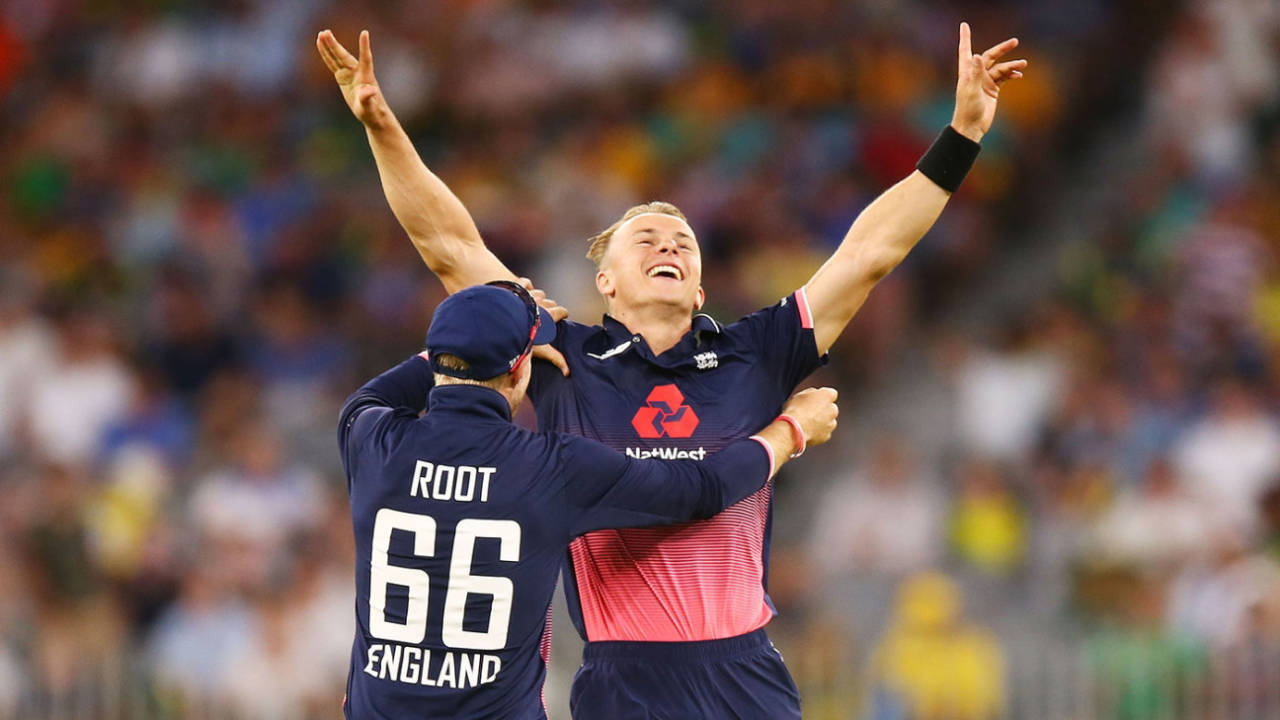Curran relishes the slow-death experience
In the winner-takes-all world of modern white-ball cricket, the only stats that matter are those in the final analysis
ESPNcricinfo staff
06-Mar-2018
Tom Curran celebrates the match-winning wicket • Getty Images
On the face of it, Tom Curran's performance in the ODI series in New Zealand has been nothing special at all. He's picked up a solitary wicket for 167 runs in three matches - even Devon Malcolm's Test debut had a better return than that - and he has been the most expensive of England's specialist bowlers in each one of those contests.
But in the winner-takes-all world of modern white-ball cricket, the only stats that matter are those in the final analysis - specifically, Curran's crucial final over in England's series-turning four-run win in Wellington.
New Zealand needed 22 runs from 12 balls to take a 2-1 lead in the series, and Kane Williamson had the bit between his teeth, when Curran ran in for the penultimate over of the innings.
He was duly slotted for a first-ball boundary that brought up Williamson's brilliant hundred, but Curran recovered with impressive poise. A diet of slower balls and cutters conceded just three more runs from five balls and left Chris Woakes with enough runs to close out the win.
Bowling at the death can look like a mug's game - just ask Ben Stokes, who for all his ability to change a match with the ball, has not been seen at the sharp end of an innings since that fateful over in Kolkata two years ago. But Curran's willingness - nay desire - to put himself in the firing line is a huge part of the battle won, and potentially a vital aspect of England's planning as they build towards the 2019 World Cup.
"You don't know until you're given the ball but I know I bowled in the games previously at the death so it wasn't a surprise to me and getting over the line with the win was very satisfying," Curran said.
"I've done it a lot of times in training and I've had time to implement it in games at Surrey and a few games for England so it's just about going out there and backing myself. It's very satisfying to see it come off."
Curran's rise to the England set-up had been telegraphed for several seasons before his breakthrough in the past 12 months, thanks to his precocious performances for Surrey - where he was able to learn many of the arts of death bowling from a practitioner who didn't always enjoy the best of times at international level.
Jade Dernbach, Surrey's captain for this year's T20 Blast, struggled at times for subtlety during his England career, often serving up too many variations too soon instead of saving them for the moments that would matter. But the skills he brought to bear were undeniably tricksy, including a back-of-the-hand slower ball that Curran has inherited for his own repertoire.
"We've closed out a lot of games at Surrey together and he's a really good friend of mine and someone who as a youngster helped me a lot growing up," said Curran. "Now it's about doing it together and you could say in the early years of my career he did help me.
"I think you've just got to try things," he added. "You have time in training to get a feel for all these different slower balls and if you don't try them you're not going to learn. A couple of years ago I just started practising different types of slower balls from the back of the hand and they seemed to work. A combination of that and the off-cutter seems to be coming off."
Putting those skills into practice, however, takes both nerve and a game brain, attributes that Curran appears to have in abundance, to judge by the faith he has so far been shown by his captain, Eoin Morgan.
"I think you get a feel for what the batsman's doing after the ball has been bowled and, walking back to my mark, I'll have a feeling," said Curran. "I don't often change. If I commit to a slower ball I commit at the top of my mark and if the batsman moves around or makes any changes of movement I can change the line or the pace but it's something I commit to at the top of my mark so once you've bowled it there's no regrets.
"I'm practising all the time, trying these new ones. Obviously the knuckle ball, and there's other slower balls that are coming out. In games at the moment I'm just using the two but there's some interesting ones coming out for the season - a work in progress so 2018 there'll be a couple more coming out."
And if those variations hit the mark this year, then there could be an even bigger incentive for Curran in 2019, when the World Cup takes place on English soil.
"That's exciting," said Curran. "It's a great place to be in. It's about me putting my hand up and performing when I do get given a chance. It's 15 months away so I'll finish this tour, go back, do my thing for Surrey and hopefully give Morgs a tough selection problem."
